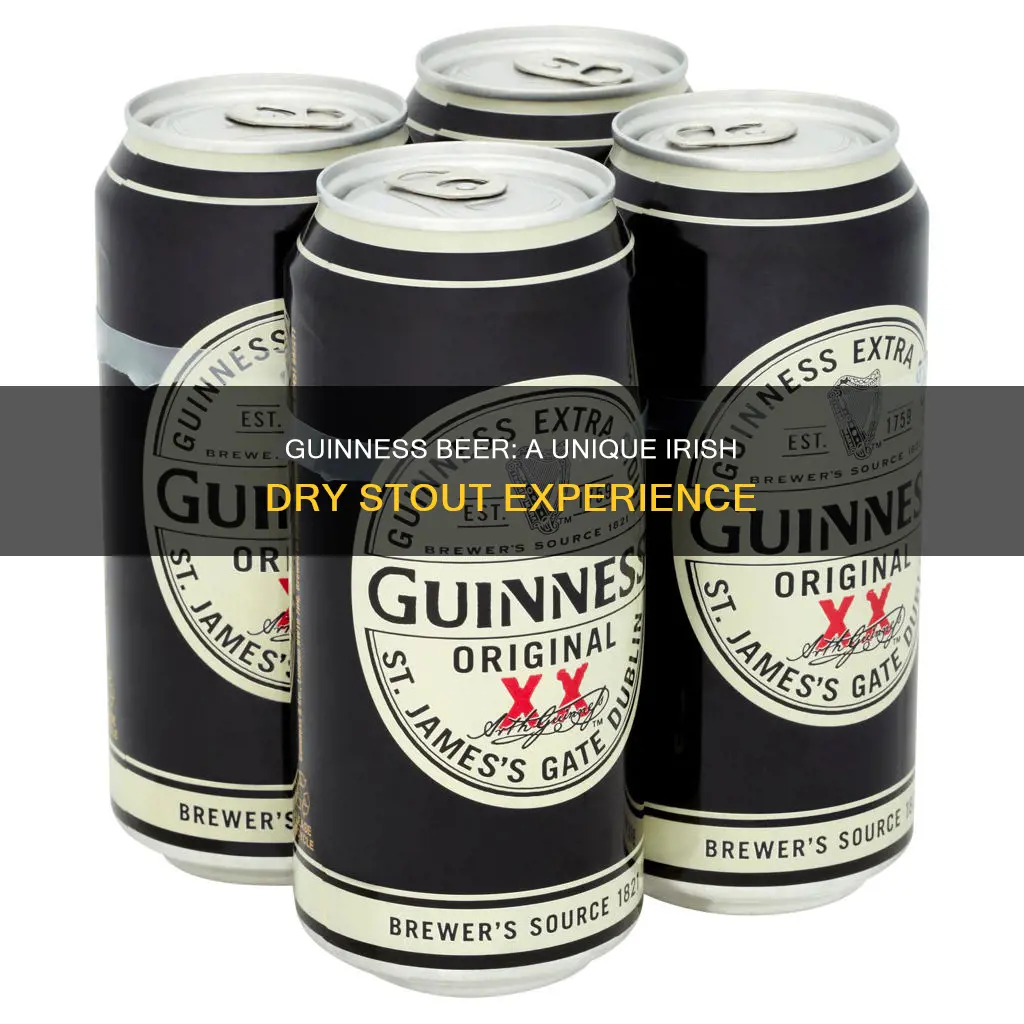
Guinness is a traditional Irish stout beer, first brewed in Dublin, Ireland, in the 18th century. It is made from barley, hops, water, and a specific strain of ale yeast, now known as Guinness yeast. The beer's deep colour and caramelised flavour come from barley that has been roasted but not malted. Guinness is nitrogenated, which gives it a creamier and smoother consistency than a beer that is carbonated with CO2.
| Characteristics | Values |
|---|---|
| Type | Stout |
| Colour | Dark ruby red |
| Flavour | Roasted coffee, chocolate, caramelised |
| Texture | Creamy, smooth |
| Taste | Bitter, sweet, roasted |
| Alcohol by volume (ABV) | 4.1% to 4.3% |
| Calories | 125 per pint |
| Country of origin | Ireland |
| Year created | 1759 |
| Creator | Arthur Guinness |
What You'll Learn

Guinness is a stout beer
The original Guinness is a type of ale known as stout. It is made from a grist (grain) that includes a large amount of roasted barley, which gives it its intense burnt flavour and very dark colour. Guinness is also known for its dense, creamy head, which is achieved by mixing the beer with nitrogen to create smaller bubbles that result in a thicker head.
The first Guinness beers to use the term "stout" were Single Stout and Double Stout in the 1840s. Throughout most of its history, Guinness produced only three variations of a single beer type: porter or single stout, double or extra, and foreign stout for export. "Stout" originally referred to a beer's strength but eventually shifted towards body and colour.
Guinness Extra Stout (or Guinness Original) is the brand's flagship beer. It is a crisp dark beer with a red hue, a balance of bitter and sweet notes, and a dry finish. It is one of the most widely sold versions of Guinness, with 4.1% and 6% alcohol by volume (ABV), depending on the country.
Guinness Draught is the draft version of the Irish stout. It is charged with a combination of carbon dioxide and nitrogen, giving the beer a smooth, velvety mouthfeel. When poured properly, the very dark beer has a dense, creamy head. It is sold in kegs, bottles, and cans that contain a nitrogen "widget" for an extra creamy head. The alcoholic content is 4.2% ABV.
Guinness Foreign Extra Stout was originally brewed stronger to survive long voyages across the sea. In most markets today, it has 7.5% ABV, with extra hops included to help preserve the beer. All of the signature Guinness flavours are amplified, and it offers a full-bodied roasted, fruity character.
Guinness Beer: Carbonation Secrets Revealed
You may want to see also

It was first brewed in Dublin, Ireland
Guinness is a stout beer that was first brewed in Dublin, Ireland, in the 18th century. The history of Guinness is closely tied to the man who created it, Arthur Guinness, who signed a 9,000-year lease on December 31, 1759, for the now-famous St. James's Gate Brewery. The brewery was unused at the time, and Guinness paid an annual rent of £45.
Arthur Guinness started brewing ales in 1759, and a decade later, on May 19, 1769, he exported his ale for the first time, shipping six-and-a-half barrels to Great Britain. In 1778, Guinness began selling a dark beer called porter, and in the 1840s, the first Guinness beers to use the term "stout" were introduced: Single Stout and Double Stout. The term "stout" originally referred to a beer's strength but eventually shifted to describe its body and colour.
Guinness's association with Ireland is strong, and it is considered the national beer of the country. The company has a long history of supporting the community in Dublin and Ireland as a whole. In the 1800s, the Guinness family contributed to the restoration of St. Patrick's Cathedral in Dublin, and Arthur Edward Guinness purchased St. Stephen's Green, a private green reserved for the city's wealthiest residents, and donated it to the city so that everyone could enjoy the green space.
The company also established welfare trusts in London and Dublin in 1890 to help underprivileged communities. In Dublin, Guinness supported families by constructing well-built flats, a hostel, an indoor food and clothes market, and Ireland's first crèche. The company also introduced employee benefits, such as paid annual holidays, free meals, annual excursions, and a beer allowance, and was a pioneer in improving employee welfare and relationships between employees and employers.
Guinness has become an iconic symbol of Ireland, with its distinctive black liquid and the harp logo, which was modelled on the Trinity College harp and adopted in 1862. The harp has long been a symbol of Ireland, appearing on the official emblem and coins of the country. The harp on Guinness's logo faces right instead of left, distinguishing it from the Irish coat of arms.
Vegan Alert: Guinness Beer's Surprising Ingredient
You may want to see also

It's made from barley, hops, water, and yeast
Guinness is a stout beer, which is a dark beer made using roasted barley. It is made from four essential ingredients: barley, hops, water, and yeast.
Barley is the main starch source in beer, and it is what gives Guinness its dark colour and characteristic taste. The barley is malted by first being soaked in water so that it begins to germinate. It is then dried with hot air in a kiln, which also develops the grain's final flavour and colour characteristics.
Hops are the spice of the beer world, adding bitterness, flavour, and aroma to the brew. They are green, cone-shaped flowers from the hop vine. When boiled with the brewing wort, they release alpha acids, which are transformed into compounds that provide the beer with its bitter taste.
Water is the main ingredient in beer, accounting for about 95% of its composition. The quality and mineral content of the water used significantly shape the beer's flavour and regional character. For example, the mineral content of the water in Dublin is well-suited to making stout, while the soft water of Pilsen in the Czech Republic is ideal for brewing Pilsner.
Yeast is a microorganism that ferments sugars extracted from grains, producing alcohol and carbon dioxide. It also influences the character and flavour of the beer. There are two main types of yeast used in brewing: ale yeast and lager yeast. Ale yeasts are top fermenters, thriving at warmer temperatures and often imparting fruity and spicy notes to the beer. Lager yeasts, on the other hand, are bottom fermenters and prefer cooler brewing conditions. They work slower and create crisper, cleaner-tasting beers.
Guinness Beer and Coffee: What's the Connection?
You may want to see also

Its nitrogen bubbles give it a creamy head
Guinness is a stout beer, originating in Dublin, Ireland, in the 18th century. It is one of the most successful alcohol brands in the world and is available in over 120 countries. The distinctive flavour of Guinness comes from malted barley and roasted unmalted barley. The draught beer is known for its thick, creamy head, which is achieved through a combination of nitrogen and carbon dioxide.
The creamy head of Guinness is a result of the nitrogen bubbles that are much smaller than carbon dioxide bubbles. Nitrogen is less soluble than carbon dioxide, allowing the beer to be put under high pressure without making it fizzy. The high pressure of the dissolved gas enables very small bubbles to be formed by forcing the draught beer through fine holes in a plate in the tap. This process creates the characteristic "surge" and gives Guinness its smooth and creamy texture. The widget in cans and bottles of Guinness also contains nitrogen, which achieves the same effect.
The two-stage pouring process further enhances the creamy head. During the first pour, the glass is tilted at a 45-degree angle and filled three-quarters full. The beer is then allowed to settle before filling the glass completely. This technique ensures that every mouthful of the pint tastes as intended by the brewers.
The creamy head of Guinness is not only aesthetically pleasing but also contributes to the overall sensory experience of drinking the beer. The small nitrogen bubbles create a smooth and creamy mouthfeel, complementing the rich and creamy flavour of Guinness.
The use of nitrogen in Guinness was introduced in 1959 by mathematician-turned-brewer Michael Ash. This innovation transformed the texture and flavour of the beer, giving it a "creamier" and "smoother" consistency compared to the sharper taste of traditional carbon dioxide-based beers.
Guinness Beer's Dark Appearance: A Black Mystery Solved
You may want to see also

It's sold in over 100 countries
Guinness is a stout beer that originated in Dublin, Ireland, in the 18th century. It is now available in over 120 countries, including the United Kingdom, Nigeria, the United States, China, and India.
The beer is brewed in almost 50 countries, including Nigeria, the Bahamas, Canada, Cameroon, Kenya, Uganda, South Korea, Namibia, and Indonesia. It is one of the most successful alcohol brands worldwide, with sales of 850 million litres in 2011.
The Guinness Storehouse in Dublin is a popular tourist attraction, receiving over 20 million visitors since its opening in 2000. The store offers a self-guided tour that includes information on the ingredients used to make the stout and the brewing process.
Guinness has a strong marketing presence, with notable advertising campaigns throughout its history, such as the "Guinness is Good for You" campaign in the 1920s and the "Guinness Greatness" campaign in the 2000s. The brand is also associated with Arthur's Day, a series of global events celebrating the life and legacy of Arthur Guinness.
The beer is known for its distinctive flavour, derived from malted barley and roasted unmalted barley, and its creamy head, achieved by mixing the beer with nitrogen and carbon dioxide. It is often served using a "double pour" technique, which involves a two-stage process to create the perfect pint.
Guinness has a rich history, dating back to 1759 when Arthur Guinness signed a 9,000-year lease for the St. James's Gate Brewery in Dublin. The brand has since become an iconic part of Irish culture and continues to be a popular beverage choice worldwide.
Guinness Beer's Ball: A Unique Brewing Mystery
You may want to see also
Frequently asked questions
Guinness is a traditional Irish stout beer.
Stout is a type of beer characterised by a dark colour and a thick, creamy head.
Guinness is made from barley, hops, water, and a specific strain of ale yeast.
The deep colour and caramelised flavour of Guinness come from barley that has been roasted but not malted.
Guinness is best served cold in a pint glass. The ideal temperature is 42 degrees Fahrenheit, but no higher than 50 degrees.







